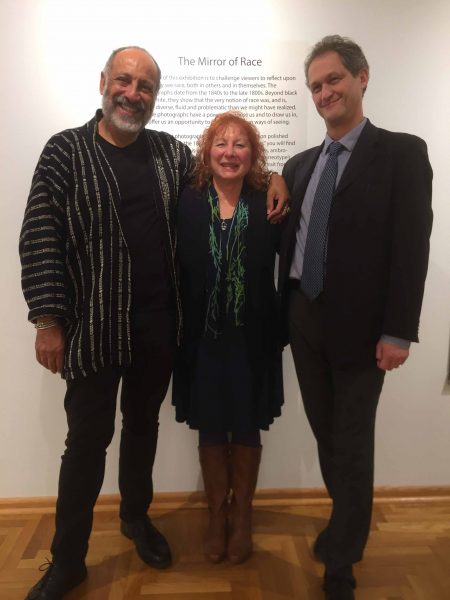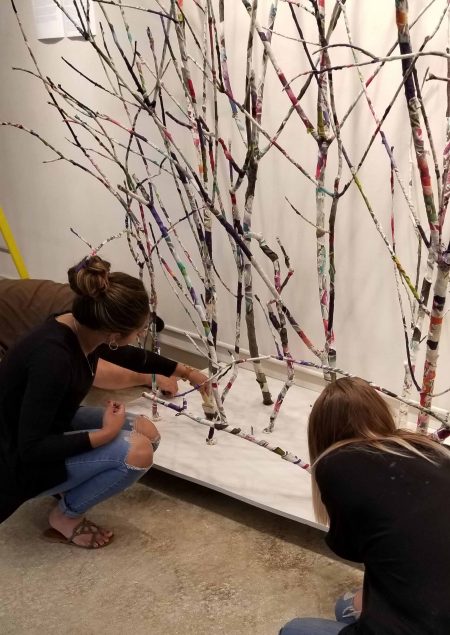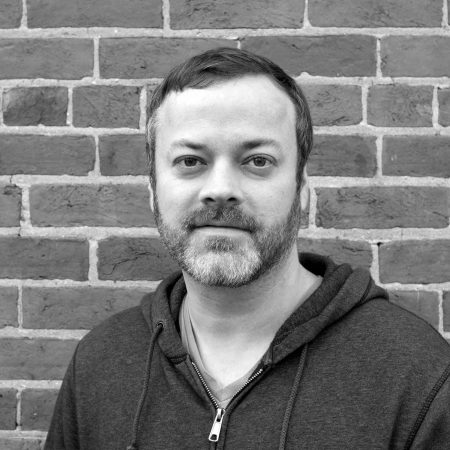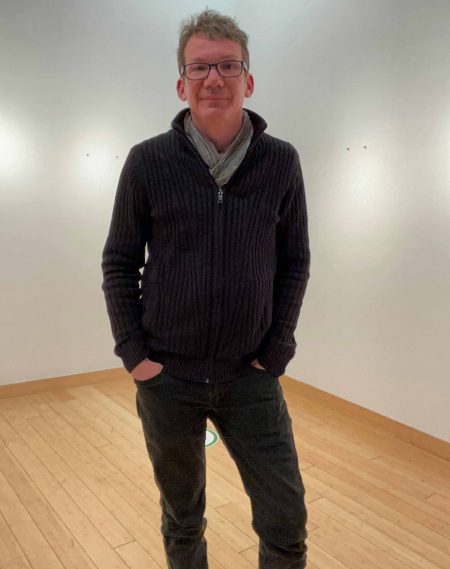I talked with several directors of art galleries at area universities. Kitty Uetz, MFA, has been director of Xavier University Art Gallery since 1997. It is located at 1658 Musketeer Drive on the first floor of the A.B. Cohen Center. It consists of two exhibition spaces totaling 1,700 square feet. The Art Gallery functions as an educational resource by hosting exhibitions of artwork by professional visual artists, the Department of Art students and faculty, as well as programs deemed to be of interest to the public.
The gallery is a learning lab for students. Uetz chooses a variety of art from seniors graduating with a degree in art to exhibit. Next semester there will be four to five exhibitions. She sees the gallery as a service to the university. She also counts the gallery lucky not to have a parking problem.
There are joint events in the gallery in normal times. These include celebration of a retirement, campus tours and poetry reading from both students and faculty. There have been fashion shows and a board meeting in the gallery. The faculty exhibits every two years, e.g., 2020 and 2022. There are also regional and national shows.
Some graduate students from other schools who need an art component participate in the exhibits. Most of the students, however, are undergraduate. This year there are 30 graduating seniors.
An unusual show is Mirror of Race: Seeing Ourselves through History with Derek Burrows, independent artist, and Gregory Field, professor of philosophy, Boston College, presented in conjunction with the Department of Art and the Ethics/Religion and Society Program. According to XU, “It is an exhibition of photographs that challenges viewers to think about what they see when they look into this mirror onto an earlier time. It includes daguerreotypes, tintypes, ambrotypes and other forms of early photography in the 19th century. The surface of these daguerreotypes is literally a mirror, so that looking into a portrait from 160 years ago shows one’s own face superimposed on the past.”

Art at the X Juried Exhibition is held biennially and open to artists 18 years of age and older. The exhibition is a national juried art competition. The last one was Celebrating 50 Years of Women at Xavier University in 2019. Ten artworks were purchased and added to the university’s Fine Art Collection. There is an entry fee and cash awards. The next Art at the X will be displayed in the Fall Semester 2021.
Uetz said it was hard to plan for 2021 with the pandemic. She operates on a modest budget. If she had more money, she would use it for publicity and documentation of the exhibits. Although FotoFocus was cancelled this year, she is using its grant money on an emergency basis. She has a videographer and hands out a printed pamphlet with exhibits.
She feels that she is fortunate to serve the university all these years. She acts as a resource for the university. “I take art to other buildings,” she said. If she weren’t the gallery director, she would spend more time with her art.
Gallery hours are M – F 10 am – 4 pm and by appointment. For more information, contact M. Katherine Uetz at 513-745-1919.
Velma Dailey started as an undergraduate student at Mount St. Joseph University. By 2012 she became director of the Studio San Guiseppe Art Gallery. She has a BFA and a certificate in education. She also has an MA in religious and pastoral studies. She was drawn to art in high school and had a career teaching K-8 at St. Francis De Sales in Lebanon, Ohio before she landed at the Mount.
The mission of Mount St. Joseph University: “It is a Catholic academic community grounded in the spiritual values and vision of its founders, the Sisters of Charity. The University educates its students through interdisciplinary liberal arts and professional curricula emphasizing values, integrity and social responsibility.
Dailey chooses exhibitions throughout the year. She hired two student workers and works with many individuals and departments across the campus in a collaborative fashion. There is interdisciplinary learning between departments such as sociology and religion. She tries to bring core values that the Mount has to the exhibitions. In addition, she teaches courses on Art Guild, Intern Gallery Management and Cherokee Culture and Spirituality.

The gallery on campus is open to the general public during normal times. Dailey has worked with a lot of artists in the TriState as well as groups such as the Clay Alliance, Craft Guild, Biennual FotoFocus and Tiger Lily Press. She partners with a number of organizations to create exhibitions in their space. “It is a close encounter for our art and design students,” Dailey said. She considers the gallery as an extension of the classroom. In addition, she invites faculty to use the gallery as a resource. The educational home for the gallery is the School of Arts and Humanities. Her budget includes six to seven exhibits each year. “I try to be frugal with that,” she said. She keeps a budget for professional exhibitions such as the international photographers show. Before COVID there were intercollegiate events such as one for the president’s luncheon and receptions.
She would do more national shows, events and engagements where students can participate if she had more money. There are approximately 100 art and design students who participate in the Mount’s shows.
Parking is available in the garage and in a few open lots. Admission to the gallery is free.
There are a lot of restrictions with COVID-19. The gallery is on a hiatus to the general public and not hosting events. Dailey is working with the Marketing Department to create an online gallery which should be available in January.
Dailey said there are larger gallery opportunities on the West side of town in response to a question about the Mount’s interaction with the arts scene in general.
She said she is honored to be the gallery director because she has had the opportunity to meet a variety of artists and arts leaders over the years. The gallery tries to bring important awareness to a number of issues. The Mount offers immersion courses, classes that enable students to experience life in another culture. “We continue to work with some of those,” Dailey said. Some of the shows focus on environmental and social issues. They open people’s eyes and understanding to these issues, according to Dailey.
Across the river in a different academic setting is Northern Kentucky University. David Knight has served as director of exhibitions and collections since 1990. He started part-time at NKU in 1989. Howard Storm, department chair, asked Knight to be director and start a new program. He put shows together, managed the schedule, built classes and hired student interns. The NKU Gallery and The Carnegie are now significant venues of art (in N. Ky.), according to Knight. “No one knew we had a gallery when I first started here,” Knight said.
Knight noticed that the galleries needed more tools, and three storerooms were eventually added. He looked for ways to improve the facility; this resulted in hardwood floors and new lighting. There are the Main Gallery with 2,000 square feet, and the Third Floor Gallery with 15,600 square feet. “Maybe someday we will get a benefactor,” Knight said referring to people interested in naming the space.

Knight is interested in the gallery being more community based. He said, “We want to engage our larger community to have exhibitions that reflect current things going on in our society today and broaden the gallery audience beyond the artist and art supporters.” For example, area high school teachers from the TriState area do projects in the summertime in the galleries. Parking is available in the garage. It is free during the receptions.
A gallery committee composed of Knight and several faculty meet to choose themes for the exhibits and identify new ideas and concepts. One example is the artistic vision of race and identity as the student body has become more diverse.
There are videos of faculty showing their work as a result of the pandemic. There are also digital versions of all of the exhibits. Because the senior show was cancelled, NKU opted for a virtual digital gallery located on Facebook. https://www.nku.edu/academics/sota/art/galleries/bfa-exhibitions.html?fbclid=IwAR1N80z-oQ128pHJugwqJFhEQfKn_pn8iKJQSh-b8udZBh2-VekZD0dcW0U.
There are eight to 12 shows per year during normal times. Knight is planning a live as well as a digital show in February. It is entitled Artistic Visions of Race and Identity to be shown in the Main Gallery as well as the Third Floor Gallery. “We are getting the hang of working in the COVID world,” he said.
NKU will participate in the virtual NCECA ceramics conference of 6,000 people to be held March 8 – April 2. Eight ceramic artists, all faculty from many different universities, will have their show in the Main Gallery. In the Third Floor Gallery will be past and current ceramic faculty members. Alumni from the ceramics field who are still practicing will exhibit in the lobby of the Fine Arts Building.
There is also a movement to engage alumni. “We invited alumni to an Art Administrator Conference, which was held in mid-September 2019,” he said. Albritton asked art administrators who were also artists to submit a piece of art that fit in a priority mailbox. They were displayed in the smaller Third Floor Gallery. Alumni talked about the challenges of being an administrator and being creative at the same time. They often serve as mentors to the students. Some alums even have their offspring in the program.
Knight has a small budget, even lower than it was 20 years ago. While he shows mostly regional artists, he would exhibit more nationally based artists if he had more money. In addition, he would do publications, add staff and apply for more grants. He would like to use the space the whole year, particularly in summer.
Knight has a staff of one – himself. “It’s a struggle sometimes. If I get sick, there’s no one to pick up the pieces.” He has to rely on colleagues and students. He fell off the ladder at home in 2003 and came into the office with two slings. He had to take a medical leave from August to November. “it really stressed me out,” he said.
He teaches classes in addition to his administrative work. One class is gallery internships where students learn how to install a gallery, give a presentation, learn framing, and find out about selling and marketing a show.
He puts in 40 hours during a regular week, but 70 hours during exhibit time. “These are intense weeks. Then you need a breather,” he said.
“Artists enjoy our space because it’s so large,” Knight said. He has several community connections and enjoys the artists he has met over the years. He notes how an exhibit can change a student’s life. “The world of academics is everchanging as I have found out working with the faculty over the years,” he said.
Matt Coors serves as exhibitions coordinator and adjunct instructor at the Art Academy of Cincinnati and Matt Dayler has been chair of print media for 18 years. They spoke about the galleries at AAC and the art program in general. Founded in 1869, AAC moved from the Cincinnati Art Museum to Over-the-Rhine at 1212 Jackson Street. The school offers a BFA, a MA in Arts Administration and an AA in graphic design.

The galleries on campus have three spaces. The largest is the Pearlman Gallery with 1,130 square feet and often focuses on specific themes with scheduled shows. Then, there is the Convergys Gallery with a semi-open space of 500 square feet. Shows vary. On the lower level is the Chidlaw Gallery of 1,000 square feet with current student shows. This gallery gets used a lot, particularly for senior shows.
The exhibitions support academic programming according to Coors. Faculty initiatives are considered.
Every other year, there is a faculty show. There was one in 2020 and will be one in 2022.
Coors said he has a budget for exhibitions. If he had more money, he would schedule shows that could be shipped to AAC and larger travelling shows. Dayler said with the limitations on the budget, he uses friends and networks to accomplish goals. Coors added, “We have to be resourceful.” They like to feature alumni as well.
The students shop around for an art program and come to AAC. Dayler said, “We get a weirder breed of kid. I prefer our kind of student. There are better relationships. There is a family feel. Housed in one building, it has good vibes.”
Coors has been with the Art Academy since September 2016. Not only does he arrange the exhibits, but he also teaches exhibition studio where students learn to curate, as well as freshman foundation classes. After he received his MFA from University of California – San Diego, he moved back to Cincinnati in 2014. His MFA meant he could also teach. Previously, he had gallery experience at Publico which closed in 2007.
Dayler specializes in print media. Originally from Canada, he went into academia. He also owns his own mural company called Chrome Projects which he runs out of The Lodge Studio in Dayton, Kentucky. He serves as the faculty representative for exhibitions and helps plan them, but Coors installs them.
The website states, “We may be small, but our commitment is big. It’s the same commitment our students make to themselves: to make the best art they can. There are core values of “radical creativity, relentless curiosity and rebellious individuality.”
The mission states “To create and sustain radical forward-thinking, contemporary visual artists and designers whose creative contributions make a substantial difference in all the lives they touch.”
AAC did have a 13-week on campus semester this fall thanks to the staff that kept faculty and students safe. Although it shut down many programs, the school had virtual 3-D renderings of artwork. Coors said, “We still had exhibitions in the gallery. We had to scrap some of the shows. We have masks and social distancing.” The gallery went to by appointment only with a virtual walk through.
Dayler said there are challenges in addition to COVID. “Art relies on people engaging with art. Everyone’s challenge is how do we teach it.”
There is an emphasis on collaboration and outreach that the school does. They participate in FotoFocus shows during normal times. Students have been able, for example, to do pop up shows at the Contemporary Arts Center and at Wave Pool Gallery. They also partnered with Matt Distel at The Carnegie which hosted the exhibition Same Again with 2020 grads through December 19.
Students are on the front line with a variety of issues and active in their discussions about them. The AAC tries to engage support of those working hard to meet their goals. Recognizing a diverse culture at AAC, a position of diversity and inclusion recently was filled.
Students and faculty take trips to art studios. They have been to New York City as well. All enriching and learning experiences. Dayler said, “There is definitely hang out time.”
AAC is in an urban setting so parking can be an issue although there is a paid lot for students.
Next on my list of people to talk with was Aaron Cowan, director of the university art collection, Design, Architecture, Art and Planning (DAAP) galleries and museum studies, at the University of Cincinnati. He has managed the Reed Gallery in DAAP and the Meyer Gallery in the Steger Center building for ten years. He took over the university art collection in June 2020. He is in his third year of managing the museum studies program. His mission is to host exhibitions that cross a broad spectrum of studies within DAAP.

“We tie into DAAP by examining practices and visual culture,” Cowan said. His programs also merge into the university in general where different viewpoints about culture are discussed.
The Reed Gallery is specifically geared toward design, architecture, art and planning. Exhibitions are thematic or feature solo and group exhibitions. It also hosts thesis shows, faculty shows, regional and national practitioners who are brought in for students to see what’s taking place in the art world.
The Meyer Gallery has a broader appeal and looks at practices within the university and experiences within visual culture. He works with such departments as geology, botany and engineering. There are senior shows, faculty shows, regional and international shows. He tries to establish professional and historic retrospectives as well.
He would mount more exhibitions, hire an assistant to develop public programming, and bring in external practitioners with thematic exhibitions that deal with contemporary culture if there were more money in the budget. He also would advocate for exhibition space.
Parking is available on the streets or in the parking garage.
There are artifacts in the UC Art Collection, engineering department, Chemistry Collection, Winkler Collection, the Medical Collection, the archives and rare books. The museum studies program provides Cowan with the opportunity to collaborate with other colleges. The program has broadened. It includes such departments as anthropology, archaeology, biology and geology. He also considers zoos and aquariums as institutions that fall under museums. The art collection has a new database, and a web page is being populated.
What Cowan finds challenging is the number of exhibitions that he can’t attend because of his schedule. He is spread thin with other responsibilities. He said, “I am resource rich and cash poor.”
On his wish list is a larger staff, public programming, a gallery on campus, and an exhibition space for the university art collection. He would like a gallery off campus where he could connect with the public on their terms. Places he considers are Camp Washington and Over-the-Rhine.
“We mount our exhibitions with the hope of our students learning to mount and install,” said Cowan.
–Laura Hobson